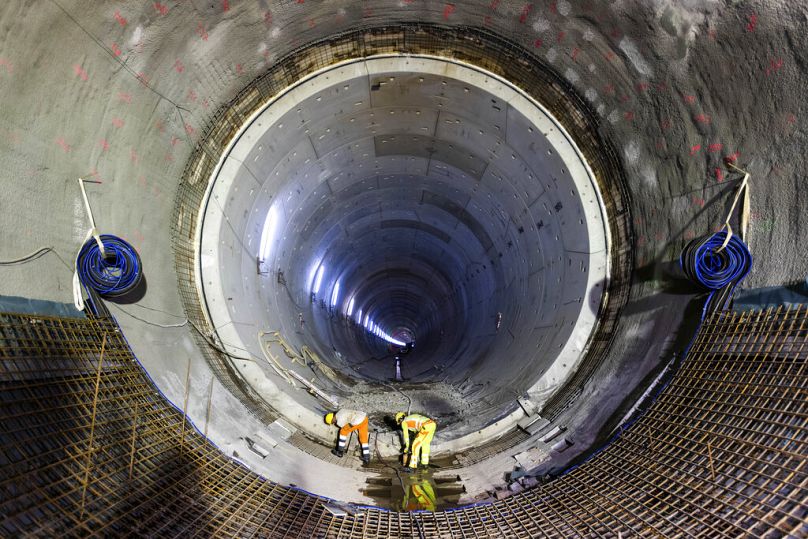Local dividend systems could positively transform infrastructure projects’ costs and timeline to completion, but also revitalise communities’ engagement in their own future, in ways that were never possible before, Taavi Kotka writes.
NIMBY, meaning “not in my backyard”, is an acronym that was coined in the early 1980s to describe neighbours who campaign against planned infrastructure or housing developments local to them.
What began then as a local community campaign against predatory commercial projects has since turned into a massive roadblock on societal development, amplifying segregation, deepening wealth inequality and robbing future generations of fair opportunities.
It’s a huge issue that doesn’t get a lot of airtime as a whole — individual protests get covered by the media, but without ever taking stock of the combined consequences of all the resulting blocked projects for a defined geographical area, such as the EU.
There is a way to engage with those yelling loudly
In most parts of the developed and democratic world, every housing, public transport or energy infrastructure project is likely to face strong resistance.
And that resistance is increasing in influence: as Brooks and Liscow’s research from 2019 demonstrates, the rise of the “citizen voice” in government decision-making is a major cause of increased expenditure — and confirms that the power of yelling loudly is becoming more and more effective.
Especially as most people who care enough to show up to a community meeting about an infrastructure project are often the very same who oppose it.
The root of NIMBY opposition often lies in totally legitimate and understandable concerns: fear of decreased property values, environmental degradation, increased traffic congestion, you name it.
Yet, these concerns, coupled with people’s natural resistance to change, have led to substantial delays, increased costs, and sometimes, outright cancellations of important projects that could have had huge benefits for those same communities in the long term.
As populations grow and live longer, so does the necessity and urgency of more infrastructure — meaning an entity like the EU which sets the agenda for regulation of these projects, faces a major challenge: balancing increasingly influential local concerns with time-sensitive societal needs.
I think there is a solution. Borrowing concepts from the world of startups, I’m convinced we can reinvent the way local communities engage with these projects in a way that creates a more cohesive, sustainable, and equitable future.
Here’s how: by creating financial incentivisation for local communities, aligning their interest with those of the projects.
Local dividends and virtual shares to the rescue
At the moment, only developers reap the financial benefits of commercial projects.
But what if we could share even just a fraction of those benefits with people who’ll be instrumental in getting the project approved? What if their tolerance could somehow be compensated for? What if there are means to involve such residents in the project, in a similar way to shareholders?
This could take the form of a "local dividend" system, where a portion of the project's profits is shared with the local community, aligning their interests with the project's success.
Such a system not only compensates for potential inconveniences but also fosters a sense of ownership and investment in the project's outcome.
And I also believe technology can help do it — via virtual shares. Done right, virtual shares could be an easy-to-implement tool that converts local opposition into a community that benefits from and votes for a project.
Those shares would give holders a set of rights, such as exit rights, allowing them to sell their shares to the acquiring company or to receive a cash payment equal to the value of their shares as part of the acquisition process, dividend rights, entitling them to the privilege to receive a portion of the company's profits in the form of dividends, and more, like redemption rights or liquidation rights.
This instrument would treat virtual shareholders in the same way as actual shareholders, just with limited rights, in particular towards governance matters — for example, virtual shareholders wouldn’t be able to elect the board members of the company.
However, when it comes to sharing financial success, virtual shareholders would be treated the same as actual shareholders.
Such virtual shares could not be bought; instead, local residents would be able to earn their shareholding in the project by conducting actions that help the project, such as participating in a local community meeting, organising a local community meeting, posting in favour of the project on social media, etc.
The proof is in the pudding
Full disclosure: this is something we built at my company — but for now it’s mostly used as a mechanism for startup founders to reward their communities of early adopters and “champions” via virtual shares when they make a contribution to the company’s growth.
It’s working incredibly well as a way to engage a wider, more diverse range of people in a collectively shared objective: financial success, beyond the capitalistic shareholder economy.
And I believe this idea can be transposed to infrastructure projects, whether it is led by us or by others. You can see an example of what’s already possible here.
No matter how entities like the EU choose to implement them, local dividend systems could positively transform infrastructure projects’ costs and timeline to completion, but also revitalise communities’ engagement in their own future, in ways that were never possible before.
Taavi Kotka is the Founder of KOOS.io. A serial entrepreneur and angel investor, he was previously the Chief Information Officer of the Estonian Government, playing a major part in its leading e-residency program.
At Euronews, we believe all views matter. Contact us at view@euronews.com to send pitches or submissions and be part of the conversation.













